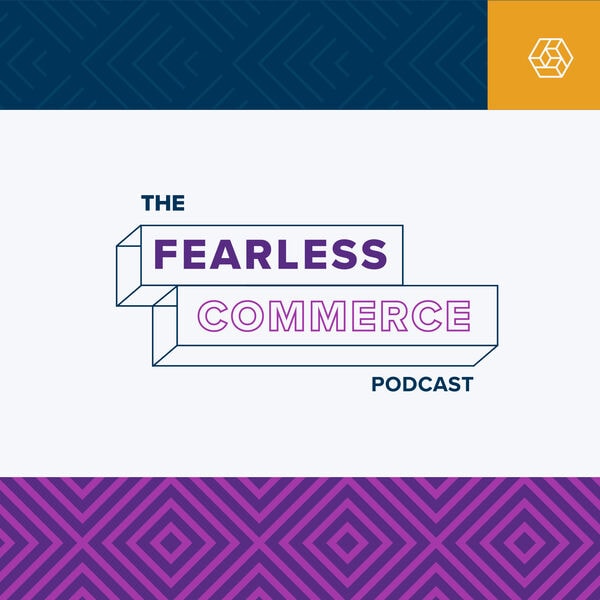Dive into the dynamic world of retail and ecommerce with us on The Fearless Commerce Podcast. Hosted by Signifyd’s Adam Silverman and Mike Cassidy, each episode promises riveting tales from retail professionals who’ve ditched their fears, embraced innovation and turned challenges into golden opportunities.
Reviewed, revised and approved by Signifyd humans.
In our first episode, we delve into Signifyd’s State of Commerce 2023 report, an exploration of, well, the state of commerce and the state of the economy and the consumer, too. Our guest Signifyd Chief Customer Officer J. Bennett uses data and expert insights to paint a vivid picture of the retail landscape, while examining the concerns and aspirations of both retailers and consumers.
Bennett talks about consumers’ serious concerns regarding inflation. This worry isn’t just a passing thought; it’s reshaping how they interact with the world of commerce. They don’t want only products; they want significant value backed by exceptional customer experiences. The shift is a wake-up call for retailers. Merchants are now on their toes, striving not just for profitability but to strike the right balance between customer service and risk mitigation.
Bennett also provides a sneak peek into the coming months, especially the upcoming holiday shopping season. The forecast? While growth might seem modest, hovering around the 4% to 5% mark year-over-year, there are subtleties in these numbers. The projected growth rates vary by vertical , and a lot depends on execution. However, Bennett saves room for optimism.. He sees the holiday period as a time of immense opportunity. The best in the retail business aren’t just waiting for customers; they’re reaching out, understanding the pulse and delivering exactly what customers want.
Bennett’s insights point to a return to the energy of a pre-pandemic holiday shopping season – an exciting time for retailers who remember the hustle and bustle of that period. Are you ready to delve deep into the currents of modern commerce? Join us for some fearless conversation.
Podcast chapters
Introduction to The Fearless Podcast
Co-hosts Mike Cassidy and Adam Silverman sit down with Bennett, Signifyd’s Chief Customer Officer. As CCO, Bennett plays a pivotal role, ensuring that retailers and financial institutions reap maximum value from Signifyd’s decision-making services, which include decisions on shipping orders, approving returns, and assessing consumer credibility.
Bennett’s role isn’t merely about decisions; it’s also about interactions. He speaks daily with a broad spectrum of retailers, from the small-scale Mom and Pop outlets to the world’s retail giants. This vantage point gifts him with a panoramic view of the retail terrain, where he observes that challenges are as varied as the businesses themselves.
There is a wide spectrum of challenges confronting retailers. Shifts of the global economy, influenced by factors like inflation, geopolitical events, and pandemic-related adjustments, impact different business segments in disparate ways. For instance, grocery sellers grapple with inflation, while U.S.-based firms that shifted to nearshoring during the pandemic might be navigating a rosier scenario.
The prevailing sentiment? Uncertainty. While some merchants lament about slipping sales and the unpredictable digital ad environment, others are flourishing, surpassing ecommerce growth and addressing scalability issues. The current landscape starkly contrasts the uniform economic downturn and subsequent rise during the pandemic, painting a picture of an industry where different players are charting diverse paths.
Retailer challenges this holiday shopping season
Consumers today are navigating a landscape shaped significantly by economic factors. According to Signifyd’s latest insights, while the savings rate surged during the pandemic, it has now settled back to pre-pandemic levels. This shift is set against a backdrop of an uncertain housing market and the omnipresent specter of inflation, making price and perceived value pivotal in online purchasing decisions. As ecommerce prices remain volatile, a more cautious and frugal approach to shopping is evident among consumers.
In this climate, essentials such as groceries have seen consistent consumer investment, while luxury items and experiences are being relegated to infrequent indulgences. Despite sectors from tech to travel showing signs of recovery, a paradox emerges: about two-thirds of Americans express anxieties about their paychecks for the coming months, reflecting an overarching theme of consumer uncertainty leading to a reduction in discretionary spending.
In the realm of travel, the data suggests a shift in consumer behavior: travel might be less frequent, but when it happens, it’s more significant. This mirrors findings from luxury retailers, who report consumers are making big-ticket credit card purchases less often. The overarching trend seems to point towards a ‘quality over quantity’ approach in consumer spending behavior, a poignant reflection of the times.
Changes in luxury retail: Average retail growth sitting at 14% for 2023
In the evolving retail landscape, the nature of the goods you sell can determine how the economic tide affects you. Retailers dealing in high-end, first-generation consumer electronics may find it challenging in the current climate. However, those positioned as marketplaces for used electronics or brands built around value and cost-consciousness are thriving. The performance deviation among ecommerce players is stark. While the average growth in ecommerce stands at 14%, some businesses are seeing spikes as high as 25%. This raises intriguing questions about the strategies driving this outperformance.
Looking ahead to the crucial 2023 holiday shopping season, retailers are navigating significant headwinds. Promotional activity is at an all-time high, conditioning consumers to anticipate discounts. This can be advantageous for the holidays, as people are poised to make online purchases during promotional periods. Amidst widespread consumer uncertainty, events like the holidays, which naturally instigate spending, coupled with promotions, may catalyze an upswing in consumer spending. Historical data from the pandemic’s onset, such as the online spending surge in May, underscores the reactive nature of consumer behavior.
This holiday shopping season will be more promotional
Bennett highlights the anticipation surrounding this year’s holiday shopping season, emphasizing that it’s expected to return to a semblance of normalcy after several years impacted by the pandemic and logistical challenges. The significance of the October-December period for retailers remains unquestionable. Retailers seem to be prioritizing retargeting their existing customer base, capitalizing on the cost-effectiveness of this approach compared to new customer acquisition. Many businesses have deployed subscription models and newsletters to engage this segment.
On the advertising front, spending has decreased across many platforms, with Facebook notably facing challenges. Only Google seems to be holding ground. The uncertainty extends to customer acquisition channels as AI disrupts search methods. Some public or near-public retailers are embracing brick-and-mortar strategies by opening a limited number of stores in key markets. These stores serve multiple purposes, including brand awareness, acting as logistics hubs, and fostering omnichannel partnerships.
The conversation about customer lifetime value (CLV) has matured. Once considered a complex metric almost akin to a Holy Grail, more retailers confidently state they’re focusing on customers with high CLV. This shift in mindset comes at a time when customer retention challenges traditional acquisition strategies. The distinction between different verticals and their unique dynamics further complicates matters.
Bennett underscores potential pitfalls using Bed Bath & Beyond as an example, highlighting the danger of an excessive growth focus that neglects core clientele. The quest for profitable growth now demands an understanding of market size and one’s position in it. Companies like Walmart have mastered this balance, demonstrating success both in-store and online. However, Bennett suggests that most businesses can’t emulate giants like Walmart or Amazon and should instead tailor their strategies around their specific product lines and customers.
On business models, the lure of the subscription approach hasn’t necessarily guaranteed success. While companies such as Amazon have thrived with Prime, others, like Rent the Runway or Stitch Fix, face challenges. Bennett ponders the potential in various subscription models and highlights the complexity of establishing retail ecosystems, citing Apple’s success in this realm.
Lastly, customer experience remains pivotal. Despite its prominence in retail discourse, many American consumers remain dissatisfied with their online shopping experiences. Ecommerce giants have set lofty standards, and the challenge lies in smaller retailers matching these expectations, especially in ensuring seamless browsing and purchasing journeys. The modern consumer’s aversion to inconvenience, honed by experiences with big retailers, places pressure on all market players to deliver optimal shopping experiences.
Are retailers meeting customer expectations?
Bennett underscores the paramount importance in today’s evolving economic landscape of retargeting channels for retailers. These channels, he insists, are essential for driving profitable sales in an environment characterized by high consumer expectations. With customer acquisition witnessing transformative shifts, understanding unit economics is imperative. This involves collecting data at every step of the customer journey to identify potential pain points and drop-offs, ultimately aiming to enhance the overall customer experience.
Bennett notes that retailers are coming to a realization – they can’t construct this data infrastructure in-house. Unlike tech giants like Google, most retailers lack the expertise to develop a comprehensive end-to-end tech stack. Instead, Bennett suggests that they leverage best-of-breed solutions available in the market. Embracing innovations in the ecosystem, including automating and eliminating customer pain points, is key. Retailers must focus on their core competency: understanding their customers and delivering the products – be they physical or digital.
A challenging economy: How merchants can respond
Bennett zeroes in on the complexities merchants face in a global market, emphasizing the challenge of balancing intricate global payment regulations with delivering unique product offerings. He asserts that true product uniqueness is rare and while innovation can offer a competitive edge, it’s fleeting. Copycats often rush in, mirroring successful strategies. A foundational aspect of a thriving retail operation, according to Bennett, lies in understanding product-market fit, ensuring robust unit economics, comprehending the customer journey, and investing in automation.
Discussing customer loyalty, Bennett highlights a retargeting conundrum: Americans’ aversion to account creation. Most retailers can identify returning customers who log in, but the challenge lies in discerning the rest. Offering the example of cart abandonment, he distinguishes between conscious abandonment and mere forgetfulness. A nuanced approach can recover potential sales — for instance, by offering deals to encourage completion of forgotten carts. He suggests consumers value convenience and deals over privacy concerns, often trading privacy for perceived value. In wrapping up, Bennett cites the State of Commerce 2023 report, noting a projected ecommerce sales rise of about 4-5% in 2023.
Treading water: Ecommerce is growing at similar rates to inflation
Bennett comments on the recent ecommerce growth rates, noting that while many might perceive a 4-5% increase as progress, it appears less significant when inflation hovers around the same figures. The sentiment among retailers, Bennett observes, is that they’re exerting considerable effort only to maintain their current position, akin to “treading water.” However, he suggests that this perspective may not fully account for potential advancements in profitability.
While top-line revenue growth may remain modest, there might be untapped potential to bolster the bottom line by enhancing operational efficiency. He advises businesses to pivot, focusing on what they can control, such as optimizing customer acquisition costs, maximizing existing customer sales, reducing overheads, and minimizing returns. Reframing the current situation, Bennett points out that maintaining growth, even at these rates, is commendable given the tremendous ecommerce surge experienced in 2019-2020. He concludes by highlighting the merits of retailers streamlining core business operations, likening it to a physical transformation where one sheds fat while building muscle. This focused approach, he insists, results in not just growth but profitable growth.
What does being fearless mean to you?
Bennett delves into the concept of “fearlessness,” clarifying that it doesn’t signify a complete absence of fear. Instead, he perceives it as embodying confidence, particularly when confronting fear, ensuring it doesn’t dictate the decision-making process. He warns against mistaking fearlessness for naiveté. Bennett underscores the importance of approaching situations equipped with knowledge and understanding, emphasizing that real winners in life take calculated and educated risks.
He associates fearlessness with facing the unknown, which he is drawn to, citing his fascination with new spaces and artificial intelligence. When probed about personal irrational fears, Bennett candidly shares that he doesn’t harbor any, even recounting an anecdote about casually removing a spider from an airplane. While he acknowledges that others might possess fears like clowns, he contemplates whether such phobias are truly irrational or simply misunderstood.
State of Commerce 2023 report
The State of Commerce 2023 report offers insightful data, emphasizing the critical link between consumers, particularly the American ones, and retailers. Drawing from the report, Bennett observes that consumer concerns primarily revolve around inflation, as they seek great value coupled with a stellar customer experience. On the other hand, retailers remain steadfast in their pursuit of profitability. In the near term, he anticipates modest growth in ecommerce, citing projections of about 4 to 5% YoY growth. This projection, however, is subject to variations depending on industry specifics and execution dynamics. Success, according to Bennett, will hinge on retailers’ ability to engage customers at the right moments, delivering value seamlessly. He envisions the upcoming holiday shopping season to resemble the pre-pandemic patterns seen in Q4 2019, marking a return to a semblance of normalcy, which might prove favorable for several retailers.
Eager for more deep dives into the world of fearless retail innovation? Don’t miss a single episode of the Fearless Commerce Podcast. Please subscribe to our YouTube channel and browse the list of podcasts for all the insights and behind-the-scenes action. If you’re always on the go, catch us at Signifyd on Buzzsprout and tune in to the voices shaping the future of retail. Dive in, stay informed, and be a part of the fearless journey with us.











